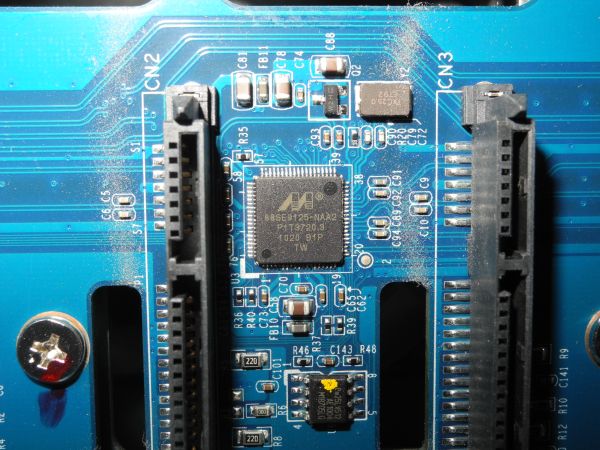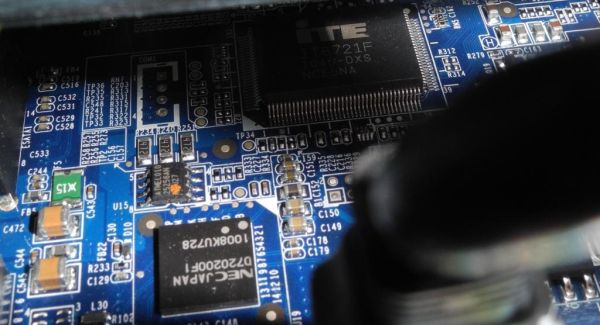QNAP TS-659 Pro II Review
by Ganesh T S on September 19, 2011 8:00 AM EST- Posted in
- IT Computing
- NAS
- QNAP
The host silicon in the SMB / SOHO NAS market is primarily from two players. While the low end is dominated by Marvell, the high end is dominated by Intel's Atom processors. As one goes higher, we have even more powerful Intel CPUs (such as the low end Core i3s). Freescale used to have some design wins till 2009 with their PPC based processors, but we haven't seen any units based on their processors in their last two years.
Removing the drive bays of the TS-659 Pro II reveals an array of 6 SATA slots and a couple of Marvell 88SE9125 chips [PDF]. These are SATA to PCI-E bridges, with support for 2 SATA devices. We believe another of these bridge chips must be present on the other side of the SATA slots array. This array connects to the PCI-E bus on the ICH9 southbridge.
Most of the high end SMB / SOHO NAS units have 1 GB of RAM which can be expanded. The TS-659 Pro II also has 1 GB of RAM expandable to 3 GB. In order to install this notebook memory, one needs to open up the unit. The brushed steel top can be removed by taking off the screws at the rear end and sliding the top out. The motherboard is covered by a screwed on plastic film with a flap above the SODIMM slot where the user can put in the additional memory.
The rest of the components are not easily accessible, but we did manage to grab a snap of the Renesas-NEC 720200 USB 3.0 to PCI-E bridge which enables the two USB 3.0 ports on the unit. The iTE IT8721F is the hardware monitor sensor and fan control chip.
In the next section, we will have the testing methodology outlined and also a description of the testbed.













69 Comments
View All Comments
meesterlars - Tuesday, September 20, 2011 - link
Sorry, Ganesh, I must have not seen that you had written the review.Yes, please do try and recreate the issues documented in the forum. Perhaps a little publicity from you guys would pressure QNAP into action.
IaninKL - Friday, May 25, 2012 - link
Hi Ganesh,I've just bought a TS-559Pro-II, so far just using it for a short-term project so have configured as JBOD and loaded about 6TB of data. 5*2TB Enterprise-grade drives.
I am wondering if the issue raised here was ever resolved?
The linked-page on the QNAP Forums has been taken down and there is no follow-up info on this thread either.
Cheers - keep up the great work!
QNAPSimon - Friday, September 23, 2011 - link
Thanks for bring this to our attention. We at QNAP are aware of the problem and have allocated dedicated resources to look into this. I will follow up on this and provide updates on our forum. If you have related concerns please email me.simonchang@qnap.com
Thanks
Hrel - Tuesday, September 20, 2011 - link
Quick search found 940 online. No hard drives inluded. Bahaha, no.MobiusStrip - Wednesday, September 21, 2011 - link
That's just ridiculous. There's no reason you should have to put drives in sleds. They should go in like cartridges, with a simple Eject button to remove them. Like these toaster-style drive docks:http://www.newertech.com/products/hdddocks.php
If locks are all that important, the lock could be above each slot and simply move a bar down to lock the drive in.
ZPrime - Friday, September 23, 2011 - link
In many systems, caddies help with noise isolation. I have several HP Home Servers and the caddies are plastic, but they have silicone/rubber grommets around a metal peg that attaches to the drives. They are tool-less, FWIW.Caddies can also help insure proper grounding. Depending on your chassis composition (some are plastic or have plastic rails), you might need some other way to get the body of the drive to ground to the chassis. Plastic caddy + metal inserts that connect to a metal latch or similar can solve this problem.
ZPrime - Wednesday, September 21, 2011 - link
Just because you have an LACP bonded connection between two machines does *NOT* mean that transfers will take full advantage of this. When you were testing for performance, did you run multiple simultaneous transfers?LACP / 802.3ad load balancing isn't as simple as people think. Bonding a pair of 1GB NICs doesn't give you "2GB of bandwidth."
Nenad - Friday, September 23, 2011 - link
In short: iSCSI >> SMB for small files and when file-cache can be usedI have QNAP TS-459 Pro+ and QNAP TS-419P , and I use them both with SMB and iSCSI.
In your test, performance of iSCSI is similar to SMB, even with write cache disabled in most parts.
But in my practice I find iSCSI has noticeably better performance in many cases, especially when you work with many small files. That can be seen on your test in 'DIR copy', but as just one number among dozen other it does not stand out. Unfortunately, it is mostly DIR copy where you need or notice speeds - copying single file will usually end fast regardless of SMB/iSCSI, video playback needs much smaller bandwith anyway etc ... it is copy of large folders with subfolders you need (and notice) speed.
Another area where iSCSI seems to have advantage is with using file-cache on windows. I'm not precisely certain how that works, but it appears that windows do not use caches so efficiently for networked/remote disk, as it does for 'local' iSCSI disk.
One practical application of this is anti-virus scanners, who tend to scan 'other' disk when you copy files - resulting in almost double time needed to copy file to/from QNAP, since for example first Norton read file from SMB share to scan, and then allows Windows to copy it locally. With iSCSI I see much smaller impact , and I believe that while Norton probably work same with reading file to scan, Windows can better use file cache to skip another reading when it needs to copy.
Carlu - Monday, October 3, 2011 - link
I love this small boxes, good power-performance ratio, but it sux when it comes to fulldisk crypto. nether the CPU has any good support for it, nor does it handles harddrives with inbuilt disk crypto. And for the same amount of money you get a 20W Xeon 20L, and a micro atx motherboard/chassi etc... and the Xeon has support for AES-IN instruction set...